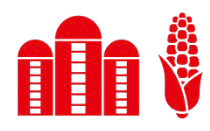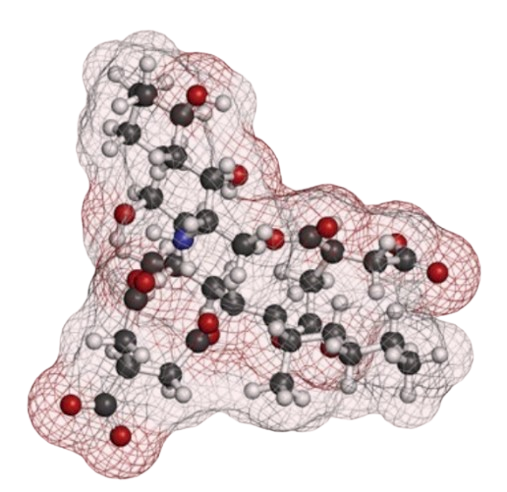Technical Bulletin for MiaBond 360 in Dairy Cattle
 Mycotoxins are secondary metabolites generated by fungi and molds that infest plants and their products during both the vegetative phase and storage (Garcia, 2023).
Mycotoxins are secondary metabolites generated by fungi and molds that infest plants and their products during both the vegetative phase and storage (Garcia, 2023).
Ruminants appear relatively tolerant of the adverse effects of mycotoxins, perhaps due to the ability of the rumen microflora to detoxify these toxins.
 However, high-producing dairy cows are thought to be more sensitive to mycotoxicosis because of their higher feed intake.
However, high-producing dairy cows are thought to be more sensitive to mycotoxicosis because of their higher feed intake.
This higher intake leads to faster passage through the digestive tract and, consequently, lower time for mycotoxin detoxification by rumen microbes (Nährer, 2015; Seglar, 2024).

 Mycotoxin binders are feed additives used in mycotoxin management to bind, neutralise, and prevent mycotoxins from entering the bloodstream (Yildiz, 2024).
Mycotoxin binders are feed additives used in mycotoxin management to bind, neutralise, and prevent mycotoxins from entering the bloodstream (Yildiz, 2024).
 MiaBond 360 is more than a toxin binder. It contains bentonite, polyphenols, fumonisin esterase enzyme, and Coriobacteriaceae bacteria.
MiaBond 360 is more than a toxin binder. It contains bentonite, polyphenols, fumonisin esterase enzyme, and Coriobacteriaceae bacteria.
![]() Hence, MiaBond 360 provides an all-round protection against mycotoxins and mycotoxin-related health issues.
Hence, MiaBond 360 provides an all-round protection against mycotoxins and mycotoxin-related health issues.
Aflatoxin is an often-found mycotoxin in animal feedstuffs (Jiang et al., 2019). Most regulations are concerned with controlling aflatoxin because it is considered the most toxic and carcinogenic of the naturally occurring mycotoxins (Whitaker & Slate, 2015).
![]() Bentonites reported the most promising results as far as aflatoxin B1 adsorption is concerned (Rodrigues, Nährer & Schwab, 2015).
Bentonites reported the most promising results as far as aflatoxin B1 adsorption is concerned (Rodrigues, Nährer & Schwab, 2015).

Not all the bentonites are the same. Namely, the aflatoxin B1 adsorption capacity of them varies.
MiaBond 360 incorporates bentonite approved by the European Union. So, it meets all the criteria required for high binding capacity.
![]() The adsorption capacity of it is not dependent upon pH level of the environment. The pH level of a healthy rumen ranges between 6.2 and 6.4. However, pH levels change in lower parts of the digestive system and can decrease up to 2 in the abomasum.
The adsorption capacity of it is not dependent upon pH level of the environment. The pH level of a healthy rumen ranges between 6.2 and 6.4. However, pH levels change in lower parts of the digestive system and can decrease up to 2 in the abomasum.
That means if any toxin binder doesn’t include high-quality bentonite, then most of the adsorbed aflatoxin molecules in the rumen will be released in the abomasum. Afterwards, they will be absorbed through the intestine, enter the bloodstream, and eventually compromise dairy cow health and performance.
The implementation of high-grain diets in dairy cows is associated with a rapid decrease in the pH of the rumen, leading to significant changes in the microbial population.
Mounting evidence indicates these types of diets are also associated with the release of high amounts of endotoxins in the rumen fluid.

Endotoxins, so-called lipopolysaccharides (LPS), are the main components of bacterial cell wall membranes of gram-negative bacteria (GNB).
![]() They are not harmful when embedded in the cell membrane, but once released they are highly immunostimulatory and largely responsible for the signs of bacterial infection. As non-fiber carbohydrates slowly increase in the diet, there is a resulting increase in GNB, while the onset of subacute ruminal acidosis (SARA) causes a major decrease in the GNB population.
They are not harmful when embedded in the cell membrane, but once released they are highly immunostimulatory and largely responsible for the signs of bacterial infection. As non-fiber carbohydrates slowly increase in the diet, there is a resulting increase in GNB, while the onset of subacute ruminal acidosis (SARA) causes a major decrease in the GNB population.
The decrease in GNB can be linked to an increase in free ruminal LPS, likely due to the death and lysis of these bacteria. SARA conditions can result in not only the lysing of GNB but also lead to lowered rumen wall integrity.
 If infected, the udder and uterus additionally become important sources of endotoxins.
If infected, the udder and uterus additionally become important sources of endotoxins.
 There is increasing evidence that endotoxins translocate from the rumen, uterus, or udder into the systemic circulation and trigger chronic low-grade inflammatory conditions associated with multiple diseases, including fatty liver, mastitis, retained placenta, metritis, laminitis, displaced abomasum, milk fever, and downer cow syndrome (Andersen, 2003; Ametaj, Zebeli & Iqbal, 2010; Chodorowska, 2016; Eckel & Ametaj, 2016; Eckel & Ametaj, 2020).
There is increasing evidence that endotoxins translocate from the rumen, uterus, or udder into the systemic circulation and trigger chronic low-grade inflammatory conditions associated with multiple diseases, including fatty liver, mastitis, retained placenta, metritis, laminitis, displaced abomasum, milk fever, and downer cow syndrome (Andersen, 2003; Ametaj, Zebeli & Iqbal, 2010; Chodorowska, 2016; Eckel & Ametaj, 2016; Eckel & Ametaj, 2020).
![]() The association of ruminal acidosis with laminitis has been well established.
The association of ruminal acidosis with laminitis has been well established.
![]() The mechanisms of development are linked to acidosis through depression of systemic pH, activating a vasoactive mechanism that increases blood pressure, which is exacerbated by factors such as histamine and endotoxin (Nocek, 1997).
The mechanisms of development are linked to acidosis through depression of systemic pH, activating a vasoactive mechanism that increases blood pressure, which is exacerbated by factors such as histamine and endotoxin (Nocek, 1997).
Lameness is associated with increased number of services per conception and consequently lower conception rates to first service (Andersen, 2003; Melendez et al., 2003; Ametaj, Zebeli & Iqbal, 2010).
Early embryonic mortality and its high frequency in lactating cows are among the causes for a decrease in animal performance, reproduction, and effectiveness of the modern dairy cattle industry as a whole (Nezhdanov et al., 2017).
![]() Such an event theoretically has no effect on oestrous cycle length and accounts for as much as 70-80% of total pregnancy wastage (BonDurant, 2004). Cullor (1993) indicated that LPS induced luteolysis and reduced conception rate and early embryonic survival through the release of inflammatory mediators.
Such an event theoretically has no effect on oestrous cycle length and accounts for as much as 70-80% of total pregnancy wastage (BonDurant, 2004). Cullor (1993) indicated that LPS induced luteolysis and reduced conception rate and early embryonic survival through the release of inflammatory mediators.
As stated above, there are tremendous negative effects of endotoxins in dairy cattle.
However, we have the chance to counteract endotoxins by using a complex toxin binder like MiaBond 360.
 Bentonite included in MiaBond 360 has a great endotoxin binding capacity that is over 99%.
Bentonite included in MiaBond 360 has a great endotoxin binding capacity that is over 99%.
Mycotoxins can increase reactive oxygen species (ROS) production, and exposure to conditions that increase oxidative stress can compromise the ability of the preimplantation bovine embryo to develop to the blastocyst stage (Jiang et al., 2019).
 The adverse effects of oxidative stress on the embryo are related not only to the direct embryotoxicity of aggressive free radicals, but also to their negative effect on the hormone-synthesizing structures of gonads and the immune system (Nezhdanov et al., 2017).
The adverse effects of oxidative stress on the embryo are related not only to the direct embryotoxicity of aggressive free radicals, but also to their negative effect on the hormone-synthesizing structures of gonads and the immune system (Nezhdanov et al., 2017).
 MiaBond 360 not only contains water-soluble polyphenols but also the fat-soluble ones. Water-soluble polyphenols support vitamin C, while fat-soluble polyphenols strengthen the stability of cell membranes. Thanks to the aforementioned compounds, we can alleviate the oxidative stress resulting from mycotoxins.
MiaBond 360 not only contains water-soluble polyphenols but also the fat-soluble ones. Water-soluble polyphenols support vitamin C, while fat-soluble polyphenols strengthen the stability of cell membranes. Thanks to the aforementioned compounds, we can alleviate the oxidative stress resulting from mycotoxins.
Zearalenol is one of the most frequently detected mycotoxins in cereals and animal feed worldwide. Zearalenol binds to estrogen receptors and exerts estrogenic effects in different animal species.
However, in the case of Zearalenol, microbiota-mediated metabolization in the rumen may not result in detoxification.
 Zearalenol is mainly converted to α-Zearalenol and to a lesser extent to β-Zearalenol in the rumen (Gruber-Dorninger et al., 2021). α-Zearalenol is 60 times as potent as Zearalenol, while β-Zearalenol is only 0.2 times as potent (Rivera-Chacon et al., 2024).
Zearalenol is mainly converted to α-Zearalenol and to a lesser extent to β-Zearalenol in the rumen (Gruber-Dorninger et al., 2021). α-Zearalenol is 60 times as potent as Zearalenol, while β-Zearalenol is only 0.2 times as potent (Rivera-Chacon et al., 2024).

Zearalenol mostly damages the reproductive system and decreases fertility in dairy cattle.
![]() The optimum surface structure of bentonite in MiaBond 360 enables ruminants to bind it effectively, prevent its absorption, and facilitate its excretion via feces.
The optimum surface structure of bentonite in MiaBond 360 enables ruminants to bind it effectively, prevent its absorption, and facilitate its excretion via feces.
Deoxynivalenol (DON) and other trichothecenes can disrupt protein synthesis, reducing white blood cell populations and limiting the production of important inflammatory mediators (Gott, 2016).
 Additionally, DON and other trichothecenes trigger the release of the satiety hormone cholecystokinin (CCK), which induces a sense of fullness and reduced feed intake (Artavia, 2024).
Additionally, DON and other trichothecenes trigger the release of the satiety hormone cholecystokinin (CCK), which induces a sense of fullness and reduced feed intake (Artavia, 2024).
 Fumonisins (FUM) are a commonly detected mycotoxin in corn silages. Rumen microbes allow FUM to bypass the rumen mostly unmetabolized. Unlike other mycotoxins, FUM is metabolized or detoxified only to a small degree in the rumen (Kemboi et al., 2020).
Fumonisins (FUM) are a commonly detected mycotoxin in corn silages. Rumen microbes allow FUM to bypass the rumen mostly unmetabolized. Unlike other mycotoxins, FUM is metabolized or detoxified only to a small degree in the rumen (Kemboi et al., 2020).

Various microbes and enzymes are added to the feed to break down some of the mycotoxins into less toxic metabolites in the gastrointestinal tract (Haladi, 2024).
 Not every toxin binder contains enzyme and bacteria. In order to prevent dairy cattle from the adverse effects of FUM and DON, fumonisin esterase enzyme and Coriobacteriaceae bacteria were included into MiaBond 360.
Not every toxin binder contains enzyme and bacteria. In order to prevent dairy cattle from the adverse effects of FUM and DON, fumonisin esterase enzyme and Coriobacteriaceae bacteria were included into MiaBond 360.
![]() Fumonisin esterase enzyme converts fumonisin into non-toxic metabolites.
Fumonisin esterase enzyme converts fumonisin into non-toxic metabolites.
![]() On the other hand, Coriobacteriaceae bacteria detoxifies DON by transforming it into non-toxic metabolites.
On the other hand, Coriobacteriaceae bacteria detoxifies DON by transforming it into non-toxic metabolites.
Bibliographical references:
Ametaj, B. N., Zebeli, Q., Iqbal, S. (2010). Nutrition, microbiota, and endotoxin-related diseases in dairy cows. R. Bras. Zootec., 39, 433-444.
Andersen, P. H. (2003). Bovine Endotoxicosis-Some aspects of relevance to production diseases. A review. Acta vet. scand., 98, 141-155.
Artavia, I. (2024). Managing mycotoxins for maximum productivity of beef and dairy cattle. Feed and Additive Magazine, March 2024, Year: 4, Issue:38, 51-53.
BonDurant R. H. (2004). Controlling what we can control:Limiting embryonic /fetal losses. The AABP Proceedings, 37, September, 2004, 97-111.
Chodorowska, Z. (2016). Hidden health threats of upsizing. Science & Solutions, a magazine of Biomin, Ruminants, Issue 37, 2016.
Cullor, J. S. (2003). Mastitis and its influence upon reproductive performance in dairy cattle. p.: 176 Proceedings of the international symposium on bovine mastitis
Indianapolis, IN. National Mastitis Council Inc. and American Association of Bovine Practitioners, Arlington, VA.
Dogan, V., Dal, S. D. (2022). Negative effects of zearalenone on reproductive productivity in dairy cattle. Veterinary Journal of Kastamonu University, 1(1), 42-57.
Duchateau, A. (2024). Mycotoxins and endotoxins: Are there any synergisms at stake?
Feed and Additive Magazine, March 2024, Year: 4, Issue:38, 30-34.
Eckel, E. F., Ametaj, B. N. (2016). Invited review: Role of bacterial endotoxins in the etiopathogenesis of periparturient diseases of transition dairy cows. J. Dairy Sci., 99, 5967-5990.
Eckel, E. F., Ametaj, B. N. (2020). Bacterial endotoxins and their role in periparturient diseases of dairy cows: Mucosal vaccine perspectives. Dairy, 1, 61-90.
Garcia, D. D. (2023). Mycotoxin control: Focusing on the problem. The animal nutrition media, nutriNews.
Gott, P. (2016). Mycotoxins, mastitis and milk. Science & Solutions, a magazine of Biomin, Ruminants, Issue 37, 2016.
Graham, M. R. (2014). Effects of lipopolysaccharide induced inflammatory response on early embryo survival in ewes. Master of Science in Reproductive Physiology, Thesis, West Virginia University, USA.
Gruber-Dorninger, C., Faas, J., Doupovec, B., Aleschko, M., Stoiber, C., Höbartner- Guꟗl, A., Schöndorfer, K., Killinger, M., Zebeli, Q., Schatzmayr, D. (2021). Metabolism of zearalenone in the rumen of dairy cows with and without application of a zearalenone-degrading enzyme. Toxins, 13(84).
Haladi, S. (2024). Mycotoxin binder is a misnomer. Feed and Additive Magazine, March 2024, Year: 4, Issue:38, 36-38.
Jackson, S. (2023). Endotoxins in animal feed and their relationship with mycotoxins. NutriNews International, September 2023.
Jiang, Y., Hansen, P. J., Xiao, Y., Amaral, T. F., Vyas, D., Adesogan, A. T. (2019).
Aflatoxin compromises development of the preimplantation bovine embryo through mechanisms independent of reactive oxygen production. J. Dairy Sci., 102, 10506-10513.
Kemboi, D. C., Antonissen, G., Ochieng, P. E., Croubels, S., Okoth, S., Kangethe, E. K., Faas, J., Lindahl, J. F., Gathumbi, J. K. (2020). A review of the impact of mycotoxins on dairy cattle health: Challenges for food safety and dairy production in Sub-Saharan Africa. Toxins, 12(222).
Lavon, Y., Leitner, G., Moallem, U., Klipper, E., Voet, H., Jacoby, S., Glick, G., Meidan, R., Wolfenson, D. (2011). Immediate and carryover effects of Gram-negative and Gram-positive toxin-induced mastitis on follicular function in dairy cows. Theriogenology, 76(5), 942-953.
McCooey, P. (2024). Understanding mycotoxin risk and the impact on egg and chick quality. Feed and Additive Magazine, March 2024, Year: 4, Issue: 38, 26-28.
Melendez, P., Bartolome, J., Archbald, L. F., Donovan, A. (2003). The association between lameness, ovarian cysts and fertility in lactating dairy cows. Theriogenology, 59, 927-937.
Nährer, K. (2015). Mycotoxins and their effects in animals. In: Guide to mycotoxins, Ed.: E. M. Binder, Biomin Edition, Erber AG, Austria, p.: 49-88.
Nezhdanov, A. G., Mikhalev, V. I., Lozovaya, E. G., Lobodin, K. A., Safonov, V. A. (2017).
Pathophysiological aspects of embryonic mortality in dairy cows. Agricultural Biology, 52(2), 338-348.
Nocek, J. E. (1997). Bovine Acidosis: Implications on laminitis. Journal of Dairy Science, 80(5), 1005-1028.
Parker-Norman, S. (2024). Leaky gut and the cost of inflammation. Feed and Additive Magazine, March 2024, Year: 4, Issue:38, 42-43.
Rani, P., Dutt, R., Singh, G., Chandolia, R. K. (2018). Embryonic mortality in cattle-A review. Int. J. Curr. Microbiol. App. Sci., 7(7), 1501-1516.
Rivera-Chacon, R., Hartinger, T., Castillo-Lopez, E., Lang, C., Penagos-Tabares, F., Mühleder, R., Atif, R. M., Faas, J., Zebeli, Q., Ricci, S. (2024). Duration of zearalenone exposure has implications on health parameters of lactating cows. Toxins, 16(116).
Rodrigues, I., Nährer, K., Schwab, C. (2015). Counteracting mycotoxins. In: Guide to mycotoxins, Ed.: E. M. Binder, Biomin Edition, Erber AG, Austria, p.: 141-162.
Seglar, B. (2024). Mycotoxin effects on dairy cattle. [online]. Available from: https://fyi. extension.wisc.edu/forage/mycotoxin-effects-on-dairy-cattle/ [Accessed 14-07-2024].
Szelenyi, Z., Szenci, O., Bodo, S., Kovacs, L. (2023). Noninfectious causes of pregnancy loss at the late embryonic/early fetal stage in dairy cattle. Animals, 13(3390).
Thatcher, W. W., Santos, J. E. P. (2003). Characterization of early embryonic death and prevention of pregnancy wastage. The AABP Proceedings, 36, September 2003, 100-108.
Tournay, A. L. (2024). Navigating mycotoxin challenges in ruminants. Feed and Additive Magazine, March 2024, Year: 4, Issue:38, 39-40.
Walker, S., Smith, R. F., Jones, D. N., Routly, J. E., Morris, M. J., Dobson, H. (2008). The effect of a chronic stressor, lameness, on detailed sexual behaviour and hormonal profiles in milk and plasma of dairy cattle. Reprod. Domest. Anim., 45, 109-117.
Walsh, S. W., Williams, E. J., Evans, A. C. O. (2011). A review of the causes of poor fertility in high milk producing dairy cows. Animal Reproduction Science, 123, 127-138.
Whitetaker, T. B., Slate, A. B. (2015). Sampling and sample preparation for mycotoxin analysis. In: Guide to mycotoxins, Ed.: E. M. Binder, Biomin Edition, Erber AG, Austria, p.: 89-118.
Yildiz, D. (2024). Feed mycotoxin binders and global market status. Feed and Additive Magazine, March 2024, Year: 4, Issue:38, 78-82.